Saunders-Roe
SR.44
SR.A/1
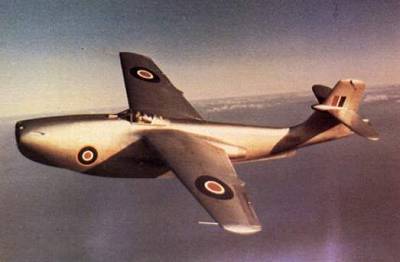
SR.A/1 TG263
Saunders-RoeSR.44 SR.A/1 |
 SR.A/1 TG263 |
The Saunders-Roe SR.A/1 originated during 1943 when Saro proposed the SR.44, a fighter which could be used in the vast ocean expanses of the Pacific Theater. It was similar in concept to the Nakajima A6M2-N "Rufe" (floatplane conversion of the infamous "Zero" fighter) and the Kawanishi N1K1 "Rex" floatplane fighters used with mixed success by the Imperial Japanese Navy. In May of 1944, a contract for three prototypes to Specification E.6/44 was awarded to Saro, and the SR.44 was subsequently re-designated SR.A/1.
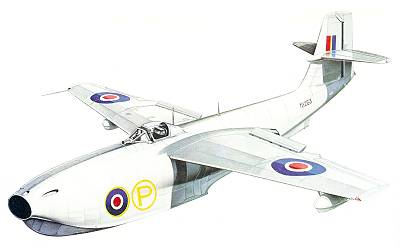 SR.A/1 TG263 |
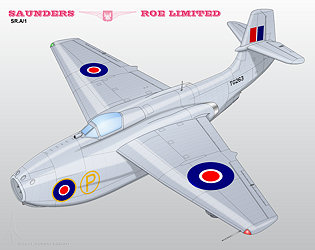 SR.A/1 TG263 (Based on a drawing from Flightglobal/Archive 1948) |
The first prototype, TG263, was powered by two 3,230 lb s.t. Metropolitan-Vickers F2/4 Beryl MVB.1 turbojets, air being provided to both engines by a nose inlet. This layout helped prevent water being ingested into the engines, this being aided further by a scoop which could be utilized during water operations. The exhausts were angled five degrees outward from the fuselage so that the efflux cleared the aircraft's empennage. The combination of boat-hull type fuselage and jet propulsion was generally more efficient than the floatplane and prop layout of the aforementioned Japanese fighters. Two further prototypes were built, serials TG267 and TG271. The second prototype was fitted with 3,500 lb s.t. Beryls and the third with Beryls rated at their full 3,850 pounds of static thrust. Crew consisted of one pilot seated on an ejection seat in a pressurized cockpit. The canopy was initially a clear hood, but was later replaced with a "solid," reinforced canopy after the clear hood was lost in flight. The proposed armament consisted of four 20 mm Hispano Mk 5 cannon, each with 190 rounds, in the upper nose, and two 1,000 lb bombs or sixteen 120 lb unguided rockets; this was not installed, however.
 TG263 on beaching gear. Via Eric Bond |
 TG263; note clear canopy hood. Via Eric Bond |
The first prototype, TG263, took to the air for the first time on 15 July 1947, with the second and third prototypes following shortly thereafter. The aircraft were flown and tested for several years. Performance and handling were generally adequate for an aircraft of the SR.A/1's size and layout, but by this time the Second World War had ended and the requirement for a flying-boat fighter had basically disappeared. Land- or carrier-based fighters offered better performance and met the current requirements. The aircraft was briefly reconsidered during the Korean War, but the last SR.A/1 still flying (the first prototype) was finally retired in June 1951, the second and third prototypes having been lost in crashes. Fortunately, TG263 was preserved at various museums, and currently resides at the Southampton Hall of Aviation.
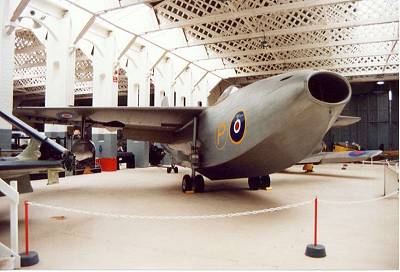
The Saunders-Roe SR.A/1 was uncommon because, not only was it a flying-boat fighter, it was both the first jet-powered flying-boat and the first jet-powered flying-boat fighter. It was also rather large for a fighter aircraft, yet still had an attractiveness to its lines. Unfortunately for Saro, it was basically a dead-end in fighter development, although the United States Navy evinced some interest in the concept as the Convair F2Y / F-7 Sea Dart, which met the same fate as the SR.A/1's development. It is interesting to imagine the service of the SR.A/1 had World War II not ended when it did.
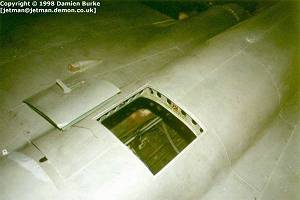 Top of fuselage of TG263, with open engine bay access hatch. Photo courtesy of and © Damien Burke |
 Inside the engine bay of TG263; the open access hatch in the previous picture is at the top of the ladder. Note that one engine has been removed; it was used to power Donald Campbell's "Bluebird" high-speed boat. Photo courtesy of and © Damien Burke |
 Cockpit of TG263. Photo courtesy of and © Damien Burke |
 1949 Saro advertisement. Via Jack Hunter |
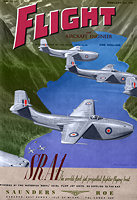 1949 Saro advertisement (colorized). Flight and Aircraft Engineer, 3 February 1949 |
Timeline
| Specifications | SR.A/1 |
| Designer(s) | Sir Arthur Gouge, Henry Knowler |
| Mission Type | Seaplane fighter prototype |
| Powerplant |
TG263: 2 x 3,230 lb (1,465 kg) s.t. Metropolitan-Vickers F2/4 Beryl MVB.1 turbojets; TG267: 2 x 3,500 lb (1,588 kg) s.t. Metropolitan-Vickers F2/4 Beryl MVB.1 turbojets; TG271: 2 x 3,850 lb (1,746 kg) s.t. Metropolitan-Vickers F2/4 Beryl MVB.1 turbojets |
| Dimensions | |
| Span | 46 ft (14.02 m) |
| Length | 50 ft (15.24 m) |
| Height | 16 ft 9 in (5.11 m) |
| Wing area | 415.0 sq ft (38.55 m2) |
| Weights | |
| Empty | 11,262 lb (5,108 kg) |
| Loaded | 16,225 lb (7,360 kg) |
| Take-off | 16,255 lb (7,373 kg) |
| Max | 19,033 lb (8,633 kg) |
| Performance | |
| Max speed | 512 mph @ hi altitude (824 km/hr) |
| Cruise speed | ? |
| Initial climb rate | 5,800 ft/min (29.5 m/s) |
| Service ceiling | ? |
| Range | ? |
| Endurance | 2.4 hr |
| Armament (not installed) |
4 x 20 mm Hispano cannon with 190 rpg in nose 2 x 1,000 lb (454 kg) bombs or 16 x 120 lb (54 kg) rockets under wings |
| Crew | One |
| User | UK (Ministery of Supply; intended for RAF service) |
| Number built | Three (five ordered) |
| Construction Numbers | ? |
| Serial Numbers | TG263, TG267, TG271 |
| Unofficial Nickname | 'Squirt' |
| Test Pilots |
Saro: Geoffrey Tyson, J. O. Lancaster, John Booth Royal Navy: Lieutenant Commander Eric Brown MAEE: Squadron Leader Pete Major, Flight Lieutenant McCall |
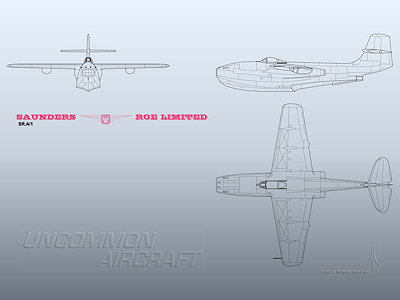 Saunders-Roe SR.A/1, initial canopy configuration, floats retracted (Based on a drawing from Flightglobal/Archive 1948) |
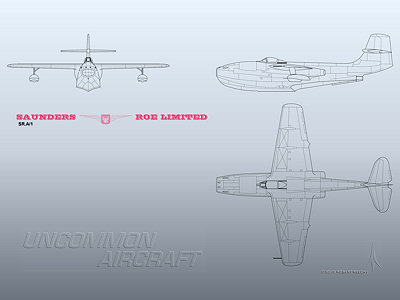 Saunders-Roe SR.A/1, initial canopy configuration, floats extended |
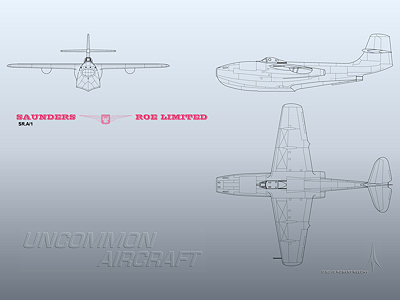 Saunders-Roe SR.A/1, revised canopy |
 Saunders-Roe SR.A/1 float details (Based on a drawing from Flightglobal/Archive 1948) |
Profiles
 Saunders-Roe SR.A/1 TG263 |
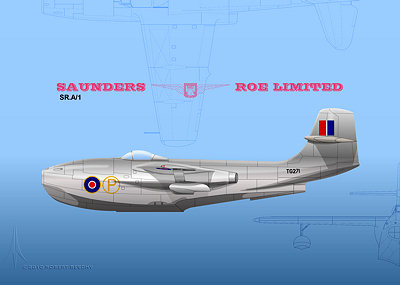 Saunders-Roe SR.A/1 TG271 |
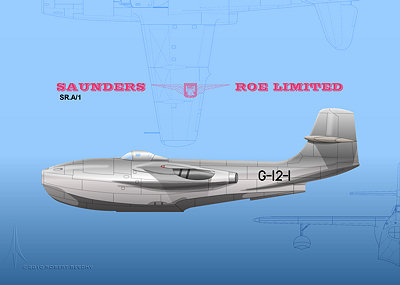 Saunders-Roe SR.A/1 G-12-1 |
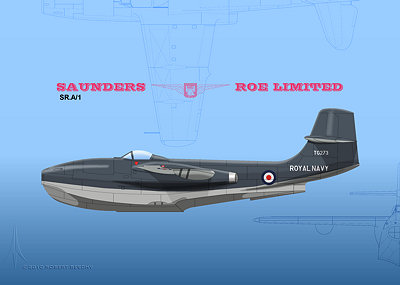 Saunders-Roe SR.A/1 as it might have looked in Royal Navy markings |
Cleaned-up Flight photos
 "S.R/A1: In his most imaginative moment the author of 'Alice in Wonderland' could hardly have foreseen a craft which is thrust by the reaction of hot gases into the air from a sea which at times literally boils around it. Such a craft is the new Saunders-Roe flying-boat fighter which, as our picture proves, however, is by no means a flying pig." (Flightglobal/Archive 1947) |
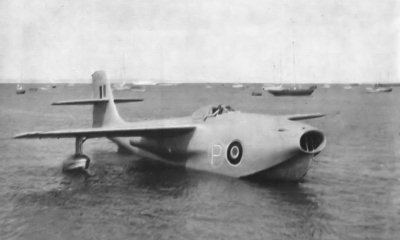 "...the Saro SR/A1 rides serenely on the tranquil waters of the Medina." (Flightglobal/Archive 1948) |
 "ELEGANT LINES: This photograph of the Saro SR-A1 fighter-boat shows clearly the neat installation of the Metrovick jet units. From the head-on aspect scarcely any bulge is noticable." (Flightglobal/Archive 1947) |
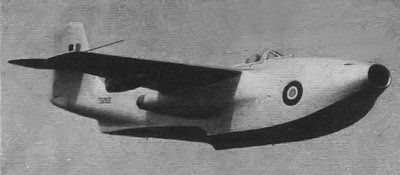 "Though lacking beauty in the classical sense, the S.R./A1 displays many attractive design features." (Flightglobal/Archive 1947) |
Web Links
Sources
| [ | Home | | | About | | | Contact | | | Top | ] |
© 1997-2011, Robert Beechy
http://fire.prohosting.com/uncommon/aircraft/sra1/index.html
Originally posted February 1998
Modified: 01/01/2011